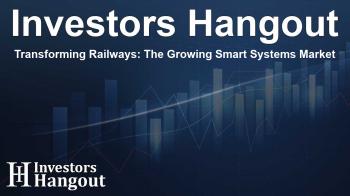Transforming Railways: The Growing Smart Systems Market

Transforming Railways: The Growing Smart Systems Market
The smart railway systems market is on the brink of massive expansion, projected to grow by USD 29.23 billion during the upcoming years. This surge is driven largely by advancements in technological efficiency and a growing focus on environmental sustainability. With the integration of artificial intelligence (AI), railways are seeing a transformation in their operations and passenger services.
Market Growth Overview
Recent insights reveal that the global market for smart railway systems is expected to experience a compound annual growth rate of nearly 14%. This growth is fueled by the need for more efficient transportation systems that can meet rising demands while minimizing environmental impact. Rail companies are increasingly adopting Internet of Things (IoT) technologies and big data analytics to enhance their operational efficiency, allowing them to reduce maintenance costs, minimize delays, and improve overall safety.
Advancements in Technology
One of the most significant trends in the smart railway systems market is the deployment of IoT devices throughout railway operations. These devices are capable of collecting real-time data, which aids in efficient monitoring and predictive maintenance. For instance, Trenitalia has demonstrated impressive cost reductions, achieving an 8%-10% decrease in maintenance expenses through strategic implementation of IoT solutions.
Innovations Assuring Passenger Safety
The market is also seeing a rise in advanced safety technologies. Automatic train protection systems and collision avoidance technology have become commonplace, enhancing passenger safety. Real-time monitoring and scheduling systems help streamline train operations, further improving punctuality and reliability.
Challenges in Implementation
Despite its rapid growth, the smart railway systems market faces several challenges that could impact implementation. The high initial investment required for infrastructure developments presents a significant hurdle for many rail operators. Additionally, smaller carriers often struggle with the costs associated with advanced technologies such as Positive Train Control (PTC). The integration of multiple technology platforms can also complicate rollout processes, making it essential for operators to have a solid strategy in place.
Need for Skilled Workforce
The demand for a skilled workforce to design, install, and maintain these sophisticated systems is another challenge. As technology evolves, ensuring there are enough qualified professionals who can manage and troubleshoot these systems is crucial for sustained growth. Furthermore, establishing regulatory frameworks to ensure safety and interoperability among various systems is imperative.
Market Segmentation Insights
The smart railway systems market is segmented into various categories, including product types, system types, and regional markets. Understanding these segments is critical for stakeholders eager to position themselves effectively in a rapidly changing landscape.
Product Types and Their Impact
This market is broadly categorized into three segments: solutions, components, and services. Solutions often encompass advanced analytics, while components include the necessary hardware like sensors and IT infrastructure. Services feature ongoing support and maintenance, ensuring systems operate at peak efficiency.
Conclusion: The Future of Rail Transport
As urbanization continues and public expectations around transportation evolve, the smart railway systems market emerges as a critical area for development. By leveraging cutting-edge technology, railway operators can enhance service reliability, safety, and efficiency while significantly reducing their carbon footprint. The focus on sustainability, combined with the need for innovation, puts the railway sector at a pivotal moment to redefine its future.
Frequently Asked Questions
What is driving the growth of the smart railway systems market?
The growth is primarily driven by technological advancements in IoT and AI, addressing the need for more efficient and reliable transport systems.
How is AI impacting railway operations?
AI enhances operational efficiency through predictive maintenance, real-time monitoring, and improved safety systems, thereby transforming passenger experiences.
What challenges does the market face?
Challenges include high infrastructure costs, a need for skilled labor, and integration issues among various technological systems.
What segments are included in the smart railway systems market?
The market segments include products, types, and geographical regions, which help stakeholders identify key areas for investment.
How is the market projected to evolve?
With growing urbanization and advancements in technology, the market is expected to continue expanding, emphasizing efficiency, safety, and user satisfaction.
About The Author
Contact Hannah Lewis privately here. Or send an email with ATTN: Hannah Lewis as the subject to contact@investorshangout.com.
About Investors Hangout
Investors Hangout is a leading online stock forum for financial discussion and learning, offering a wide range of free tools and resources. It draws in traders of all levels, who exchange market knowledge, investigate trading tactics, and keep an eye on industry developments in real time. Featuring financial articles, stock message boards, quotes, charts, company profiles, and live news updates. Through cooperative learning and a wealth of informational resources, it helps users from novices creating their first portfolios to experts honing their techniques. Join Investors Hangout today: https://investorshangout.com/
The content of this article is based on factual, publicly available information and does not represent legal, financial, or investment advice. Investors Hangout does not offer financial advice, and the author is not a licensed financial advisor. Consult a qualified advisor before making any financial or investment decisions based on this article. This article should not be considered advice to purchase, sell, or hold any securities or other investments. If any of the material provided here is inaccurate, please contact us for corrections.

